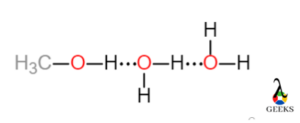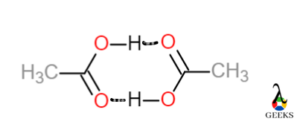In this article, we are going to see about hydrogen bonding, intermolecular hydrogen bond examples with facts in detail.
Following are the examples of intermolecular hydrogen bond.
The term hydrogen bond is used when there is a covalent bond present between the hydrogen atom and an electronegative atom, another electronegative atom having lone pair attracts an electropositive hydrogen atom by electrostatic dipole-dipole interactive force. The covalent bond is represented as a dashed line and the hydrogen bond is shown by a dotted line.
Hydrogen bonding shows two types of bonding:
- Intermolecular hydrogen bonding: When the hydrogen bond is formed in between more than one molecule.
- Intramolecular hydrogen bonding: The hydrogen bond is present in the identical molecule.
Intermolecular hydrogen bond
When a hydrogen bond is present between more than one different molecule, it is called an intermolecular hydrogen bond. The electronegative atoms like oxygen, fluorine, nitrogen, etc. formed a covalent bond with the electropositive hydrogen atom. Due to the presence of an electrostatic dipole-dipole interactive force, the compounds having this type of hydrogen boding show high melting and boiling point, solubility
Also Read On: 4 Hydrogen Bond Examples : Detailed Insights And Facts
Intermolecular hydrogen bond examples
Alcohols
In organic chemistry, alcohols have –OH, as a functional group. The hydrogen atom formed a covalent bond with the oxygen atom. The oxygen atom is electronegative having lone pair of electrons that has a partial negative charge. Which attracts the electropositive hydrogen atom of another alcohol molecule. An example of the intermolecular hydrogen bond is shown in the figure below.

Ammonia (NH3)
In the Ammonia molecule, The electronegative nitrogen atom linked with three hydrogen atoms . The nitrogen atom has lone pair hence it acquires a partial negative charge and attracts an electropositive hydrogen atom of another ammonia molecule with the help of electrostatic dipole-dipole interaction force. Thus, the intermolecular hydrogen bond get formed as shown in figure below.

Carboxylic Acid
In the carboxylic acid molecule, the carbon atom is bonded with oxygen and hydroxide group, having –COOH as a functional group. Both the oxygen atoms have lone pairs. They are electronegative in nature, acquire a partial negative charge. They attract hydrogen atoms having a partial positive charge of another carboxylic acid molecule and forms intermolecular hydrogen bonds.

Hydrogen fluoride (HF)
In the hydrogen fluoride (HF) molecule, the fluorine atom is highly electronegative compared to the electropositive hydrogen atom. The hydrogen atom had a partial positive charge on the other hand fluorine atom had a partial negative charge. It attracts the hydrogen atom of another H2S molecule and forms an intermolecular hydrogen bond.

Water (H2O)
In a water (H2O) molecule, the oxygen atom is linked with hydrogen atoms. The hydrogen is more electropositive than Oxygen, had a partial positive charge, while oxygen had a partial negative charge. Due to the presence of dipole-dipole interactive force, it attracts hydrogen atoms, having a partial positive charge of the separate water molecule. Hence water has a high boiling point.

Also Read On: 5 Polar Covalent Bond Examples: Detailed Insights And Facts
Facts
- Hydrogen bond forms due to the dipole-dipole interactive force of attraction.
- Two types: 1)Intermolecular hydrogen bonding 2)Intramolecular hydrogen bonding.
- Intermolecular hydrogen bonding: when the hydrogen bond is formed in between more than one molecule.
- Intramolecular hydrogen bonding: The bond exits in the identical molecule.
- Hydrogen bonding is not stronger in comparison to covalent and ionic bonding.
- The compounds which have hydrogen bonding, show high melting and boiling points.
- The compounds with hydrogen bonds show properties like surface tension, solubility, viscosity etc.
Also Read On: 15 Coordinate Covalent Bond Examples: Detailed Insight And Facts
Frequently Asked Questions:
1) Question: What is hydrogen bonding?
Answer: The term hydrogen bonding is used,
When there is a covalent bond present between the hydrogen atom and an electronegative atom, another electronegative atom having lone pair attracts an electropositive hydrogen atom by electrostatic dipole-dipole interactive force.
2) Question: Do hydrogen bonds share electrons?
Answer: No, hydrogen bonds don’t share electrons.
The electronegative atoms having a partial negative charge attract electropositive hydrogen atoms. Both oppositely charged atoms move closer to each other but the sharing of electrons does not take place.
3) Question: How do hydrogen bond forms in water?
Answer: The hydrogen bond is present in the H2O molecule,
In a water (H2O) molecule, the oxygen atom is linked with hydrogen atoms. The hydrogen is more electropositive than Oxygen, had a partial positive charge, while oxygen had a partial negative charge. Due to the presence of dipole-dipole interactive force, it attracts hydrogen atoms, having a partial positive charge of the separate water molecule. Hence water has a high boiling point.
4) Question: What is the intermolecular hydrogen bond?
Answer: The intermolecular hydrogen bond is,
When a hydrogen bond is present between more than one different molecule, it is called an intermolecular hydrogen bond The electronegative atoms like oxygen, fluorine, nitrogen, etc. formed a covalent bond with the electropositive hydrogen atom. Due to the presence of an electrostatic dipole-dipole interactive force, the compounds having this type of hydrogen boding show high melting and boiling point, solubility.
I am Smruti Bhosale. I am from Mumbai. I have Master’s degree in Inorganic chemistry from Guru Nanak Khalsa College, Mumbai. I always have a passion for writing and to inspire as many willing minds through my words. Chemistry is a subject that is used by everyone in their normal lives.
I want to explain the subject in the most understandable and simplest way possible. I am a creative, hard working person and passionate about learning new things. I like to read books.